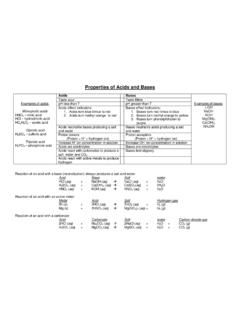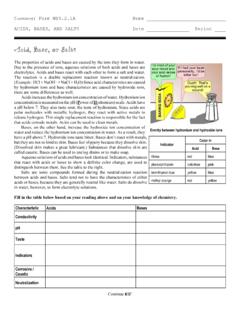Transcription of Quiz - Equilibrium, Acids & Bases
1 Quiz - equilibrium , Acids & Bases multiple choice Identify the letter of the choice that best completes the statement or answers the question. CONTENT REVIEW ____ 1. Chemical equilibrium exists when a. no processes occur. b. two similar forward processes occur. c. two opposing processes occur at different rates. d. two opposing processes occur at the same rate. ____ 2. Any chemical reaction in which the products can regenerate the reactants is called a(n) a. double-replacement reaction. c. reversible reaction. b. single-replacement reaction. d. irreversible reaction. ____ 3. What symbol is used to indicate a reversible reaction?
2 A. c. R b. d. ____ 4. What is the general relationship between the concentration and the rate of a forward reaction? a. Rate is greater when product concentration is greater. b. Rate is greater when reactant concentration is greater. c. Rate is greater when reactant concentration is lower. d. No relationship exists between concentration and rate. ____ 5. What symbol is used to denote concentration? a. ( ) c. b. [ ] d. C ____ 6. At chemical equilibrium , which of the following is always true of the concentrations of reactants and products? a. They are constant. c. Reactant concentration is zero.
3 B. They are equal. d. Product concentration is zero. ____ 7. What is the equilibrium constant for the general equation aA bB cC dD? a. c. b. d. ____ 8. The symbol for the equilibrium constant is a. C. c. Keq. b. Ksp. d. Q. ____ 9. The principle that relates changes imposed on equilibrium systems to equilibrium position is a. Haber's law. c. Le Chatelier's principle. b. the law of chemical equilibrium . d. Avogadro's principle. ____ 10. If a change in conditions is imposed on a system at equilibrium , the equilibrium position will always a. remain the same. b. shift to favor products.
4 C. shift to increase the change in conditions. d. shift to reduce the change in conditions. ____ 11. What will happen when additional reactant is added to a system at equilibrium ? a. More products will form. b. All the added reactants will change to products. c. More products will change to reactants. d. Nothing will occur. ____ 12. In the Arrhenius definition, an acid is a substance that a. turns litmus paper from blue to red. b. has a sour taste and neutralizes Bases . c. furnishes hydrogen ions in water solution. d. furnishes hydroxide ions in water solution. ____ 13. Which of the following is produced from the neutralization of an Arrhenius acid with an Arrhenius base ?
5 A. a metal c. a salt b. an indicator d. depends on the acid and base ____ 14. In the Br nsted-Lowry definition, an acid is a substance that a. donates protons. c. neutralizes hydronium ions. b. accepts protons. d. forms a salt. ____ 15. The origin of the word acid relates to Acids ' taste, which is best described as a. bitter. c. sour. b. sweet. d. salty. ____ 16. The characteristic taste of Bases is best described as a. bitter. c. sour. b. sweet. d. salty. ____ 17. A smooth, slippery feel is associated with a. Acids . c. salts. b. Bases . d. indicators. ____ 18. The reaction of Acids with metals produces the gas a.
6 Oxygen. c. neon. b. nitrogen. d. hydrogen. ____ 19. Because Acids and Bases are conductors of electricity, they are referred to as a. indicators. c. insulators. b. electrolytes. d. capacitors. ____ 20. Substances that change color when added to Acids or Bases are called a. indicators. c. insulators. b. electrolytes. d. capacitors. ____ 21. The ionic compound formed in an acid- base neutralization reaction is a(n) a. indicator. c. hydroxide. b. hydride. d. salt. ____ 22. In a neutralization reaction, the individual properties of the acid and base a. are destroyed. c. become more basic.
7 B. become more acidic. d. are reinforced. ____ 23. A substance that can act as either an acid or a base is described as a. neutral. c. conjugate. b. ambidextrous. d. amphoteric. ____ 24. The relative strengths of Acids are determined by the extent to which the acid particles a. eat holes in clothing. c. are able to stay together. b. ionize in water solution. d. retain their shape. ____ 25. The reaction of a weak acid with water can be described as a. complete. c. incomplete. b. violent. d. spontaneous. ____ 26. What is the correct name of the acid HNO2? a. nitric acid c. nitrite acid b.
8 Nitrous acid d. nitrate acid ____ 27. The correct name of the acid HBr is a. hydrobromic acid. c. bromate acid. b. hydrobromous acid. d. bromite acid. CONCEPT MASTERY Use the diagrams to answer the questions or complete the statements. Figure 18-1 ____ 28. In the experiment shown in Figure 18-1, a gas is given off, collected in a test tube, and then tested with a burning splint. A pop is heard. What is the gas? a. oxygen c. hydrogen b. nitrogen d. need more information ____ 29. What particles will the solution in Figure 18-1 contain? a. H+ ions and NO ions c. HNO3 formula units b.
9 HNO3 molecules d. HNO3 /H2O complexes Acid Reaction Ka (AT 25 C) hydrofluoric HF + H2O H3O+ + F 10 4 formic HCOOH + H2O H3O + HCOO 10 4 hydrocyanic HCN + H2O H3O + CN 10 10 hydrogen carbonate ion HCO3 + H2O H3O+ + CO32 10 11 Figure 18-2 ____ 30. Identify the strongest acid in Figure 18-2. a. HF c. HCO3 b. F d. CO32 Figure 18-3 ____ 31. In Figure 18-3, which substance is a binary acid? a. substance a c. substance c b. substance b d. substance d ____ 32. Which substance in Figure 18-3 is an oxy acid? a. substance a c. substance c b. substance b d.
10 Substance d ____ 33. Which substance in Figure 18-3 is the carboxylic acid? a. substance a c. substance c b. substance b d. substance d ____ 34. Which substance in Figure 18-3 has an acidic hydrogen? a. substance a only c. all of the above b. substances a, b, and c d. none of the above choices ____ 35. Which substance in Figure 18-3 would have the prefix hydro in its name? a. substance a c. substance c b. substance b d. substance d PROBLEM SOLVING Use the skills you have developed in this chapter to solve each problem. 36. Write an equilibrium expression for the reaction 2 HCl (g) H2 (g) + Cl2 (g).





